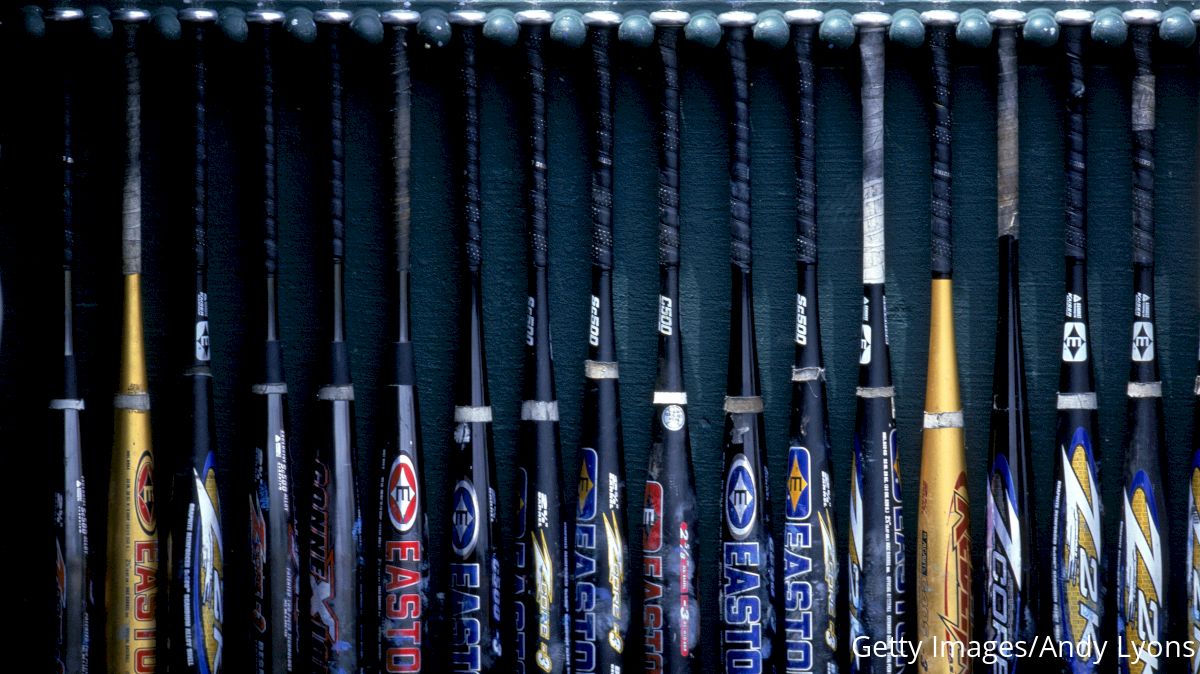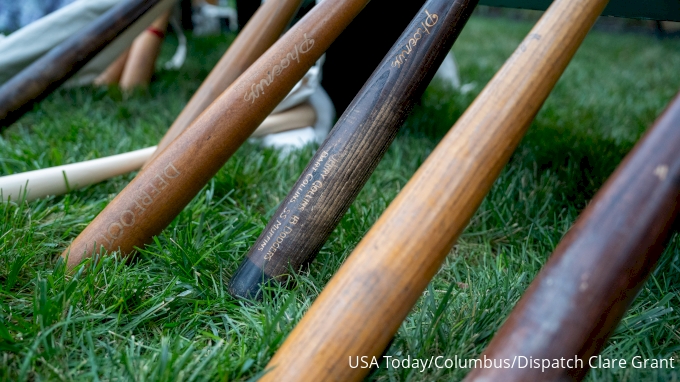Why Does College Baseball Use Aluminum Bats?
Why Does College Baseball Use Aluminum Bats?
Here’s a FloBaseball guide to college baseball bats and why most of the collegiate game opts for the aluminum/metal versions, rather than wooden ones.

Depending which level of baseball you decide to buy a ticket to watch, you may hear distinctly different sounds when a batter connects with a pitch.
In the professional ranks (including Major League Baseball), you’ll hear the sound arguably most synonymous with baseball – the cracking of a wooden bat.
In the college game and most other levels below it, however, you’ll hear metal making contact with the ball, like you decided to hit something against a fencepost.
Why is that? Why does one level of baseball choose to use one bat, while another opts for a different type?
There are reasons, and in college baseball – where some of the top professional prospects are honing their games and trying to catch the eyes of major-league suitors – that’s especially true.
Here’s a FloBaseball guide to college baseball bats and why most of the collegiate game opts for the aluminum/metal versions, rather than the wooden ones you’ll see at a professional game.
Why Does College Baseball Use Aluminum Bats?
The main reason comes down to a simple answer – money.
Though aluminum bats can cost upward of several hundred dollars at the top levels and often are more expensive at purchase than a wooden bat, the key is longevity and a return on investment.
Wooden bats tend to eventually break after frequent use, requiring a replacement. Aluminum bats, on the other hand, don’t break as often, and it’s not unheard of to go an entire college career using the same bat.
As the vast majority of college baseball programs lose money and don’t turn a profit, any way to cut costs often is sought after by schools. Using aluminum/other metal bats vs. wood bats is one way this is done.
Swing Kings.#GoGators pic.twitter.com/JS0NVFc2JN
— Florida Gators Baseball (@GatorsBB) June 26, 2023
What Bats Are Legal And Illegal In College Baseball?
The NCAA rulebook has an entire section dedicated to bat testing, which is conducted prior to the first game of a series, tournament or before the start of single games or doubleheaders.
There are a lot of rules and specifics to what makes a bat legal, but basically, the bat must be in good working order and fit the NCAA’s specifications to be approved.
These tests include being passed through a ring in order to determine if it’s of legal diameter, the barrel undergoing a compression test and if it’s on the NCAA’s approved bat list.
The NCAA has gone through numerous bat-related switches and controversies in its history, such as adopting the BESR (Ball-Exit-Speed-Ratio) standard in 1999, imposing a brief composite bat ban in 2009 and the adoption of the BBCOR (bat-ball coefficient of restitution) standard in 2011, but if there are any questions, a lengthy list of bats approved by the NCAA is available online for reference.
Has College Baseball Ever Used Wooden Bats?
The NCAA, by and large, switched from wooden to aluminum bats in 1974 in response to rising costs. Today, wooden bats aren’t technically banned for use by the NCAA, and though they rarely are used nowadays in college baseball, they’ve produced great results in the right hands.
An ex-Oregon infielder and 2023 MLB Draft pick of the Chicago White Sox, Rikuu Nishida, hit .312 last spring while frequently swinging a wood bat, for example, which he preferred to metal.
In certain corners of the country, however, you can find college baseball leagues that only use wooden bats.
The junior-college Scenic West Athletic Conference, for example, is one of the few college baseball leagues (not counting summer wood-bat leagues, which this piece will touch on later) that opts for wood bats over metal ones for conference play, giving a rare spring exposure for college players – such as Bryce Harper, who played in the conference before going on to be a two-time National League MVP – to wood and more professional-like equipment.

Have There Been Calls To Switch To Wooden Bats In The Future?
Even for those who wish to see wooden bats return en masse in college baseball, it’s likely not going to happen anytime soon.
Many programs are sponsored by metal bat companies and receive free equipment as a result, meaning it wouldn’t make sense for an entire team that otherwise has an endorsement deal to give it up and willingly incur potentially thousands of dollars of costs to switch to wood.
Bat Digest tracked just one at-bat during the NCAA Super Regional round last spring that featured a wood bat (Oregon’s Nishida, who did it once), for instance, as many of the teams had partnerships with bat companies.
Plus, metal bats have a larger sweet spot and less variability (breakage, performance in weather conditions, etc.), among other major differences, that make them more appealing in terms of game action – more balls put in play will equal more scoring.
Pro Baseball Uses Wood Bats, So How Can Scouts Properly Evaluate Prospects?
It’s a fair question, but there’s an answer beyond only college baseball itself. Enter the world of summer collegiate baseball leagues.
FloBaseball did an entire article breaking them down and explaining how they work, and for college baseball players who have dreams of making it to the pros, they’re vital tools in proving to scouts that they can produce with major-league materials.
Summer collegiate baseball leagues use wooden bats (hence the nickname they’re often referred to as, wood-bat leagues), giving professional organizations more of a true indicator to how a hitter can produce while handling the differences of a wood bat – they’re usually heavier than metal, meaning there is a greater emphasis on swing mechanics – while facing a similar level of competition.
Those who thrive in summer collegiate baseball leagues can rocket their draft stock and can enter future college seasons with tons of buzz.

Does The Type Of Bat Used Really Matter In Baseball?
Very, very much so. There’s a reason MLB and its affiliates have banned metal bats, after all.
Due to the massive skill difference between the average major-league player and the average college player and how fast the game is played (literally through pitch speeds, swing power, exit velocity and more) at the highest level, it would be both an unfair advantage for those with elite power.
Home-run numbers likely would skyrocket, and the environment overall could be unsafe, as the increased exit velocities could create a dangerous scenario with less time for an infielder to react, leaving pitchers and infielders open to a potential surging comebacker that could inflict serious injury or even death.
The “ping” sound of an aluminum bat is strictly one for Little Leaguers, travel teams and college baseball players across the globe, and it’s likely to stay that way, as the nostalgic crack of the wooden bat sticks around in the professional game.